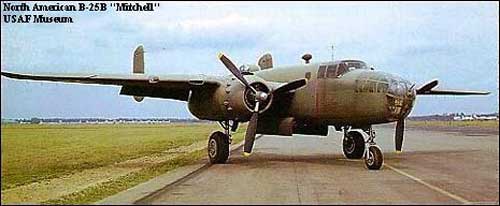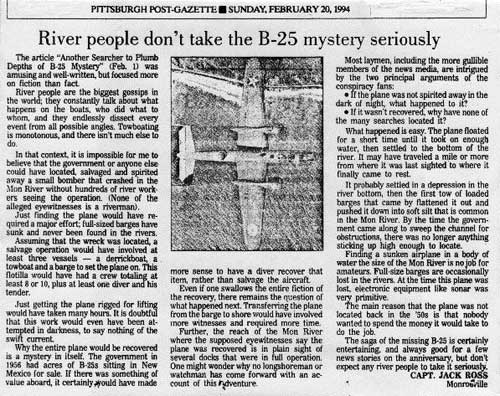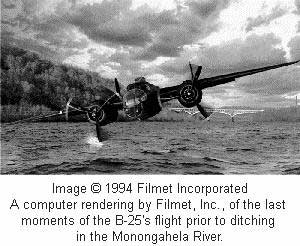 by Bob Ciminel August 19, 2004

Given the current weather conditions and an estimated 375 gallons of fuel remaining in the tanks, the crew calculated that the plane had more than enough fuel to make the one hour and 40 minute flight from Selfridge to Olmstead AFB, near Harrisburg, Pennsylvania, where they were scheduled to land and pick up some aircraft parts before continuing on to Andrews AFB. Confident that the fuel situation was under control, the crew departed Selfridge at 2:43 p.m. on a southeasterly heading toward Pittsburgh The flight was uneventful until the B-25 was approximately 17 miles northeast of the Greater Pittsburgh Airport. The crew noticed that the fuel gauge readings had changed for the first time since leaving Selfridge. Puzzled, but not worried, the crew continued flying eastward another 31 miles beyond the Pittsburgh airport. At this point, the crew saw a rapid drop in the fuel gages. They showed only 120 gallons of fuel left in the tanks. The crew radioed Greater Pittsburgh Airport, announcing their intentions to return for an emergency landing. The plane made a 180-degree turn and descended to 3,000 feet for a visual approach to the airport. As they approached the city, the crew altered course slightly to the south to avoid heavily populated areas. However, they soon realized they would not reach Greater Pittsburgh Airport, and decided to try for a landing at Allegheny County Airport, which was off to their left and closer to their current position. At approximately 4:10 p.m., both
The accident report never discusses the skill of the pilot, but he had to be exceptional. The Homestead High Level Bridge, 110 feet above the river, was directly in the plane's path. One mile downstream was a 50-foot high railroad bridge. There was a 10-knot cross wind. The river curved to the north, and was only 500 to 1,000 feet wide. The pilot was able to thread the needle and set the plane down in mid-channel, halfway between the two bridges and with no injuries to the four-man crew or its two passengers. The plane stayed afloat for approximately 15 minutes, which was ample time for the crew and passengers to get out and swim to large pieces of debris floating nearby. All but two of the plane's occupants were rescued. One passenger and one crew member disappeared into the river and were not seen again. A coordinated search and rescue effort began immediately, but the missing personnel were not found. The next day, Air Force, Coast Guard, and local authorities began dragging the river to recover the plane. This went on for about two weeks using salvaging equipment borrowed from the Army Corps of Engineers, but the plane was never recovered. Or, at least that's the Air Force's story. Various witnesses say the plane was recovered, crated up and shipped out in the dead of night, but to this day the plane and its mission have remained shrouded in mystery. Rumors were rampant: The plane was swallowed up by a vast underground river that flows beneath the city. The plane was recovered, but the Air Force kept it a secret. The passengers were aliens being transported to Washington from Roswell, New Mexico. The plane was carrying a top secret fuse assembly for nuclear weapons. 
Admittedly, this theory may
seem a bit far fetched. A concerted underwater search in 1995
using side-scanning sonar picked up something purported to be
the missing B-25 in the bottom of an old gravel pit dredged in
the river bottom, but it could have been one of the thousands
of coal barges that have sunk in the river over the past century.
Nine years later, the B-25 is still missing, and no one has come
up with a more plausible explanation than the acid corrosion
theory. Someday, this 48-year old mystery will be solved and
Pittsburghers will finally learn what happened to their missing
bomber.
|
||
